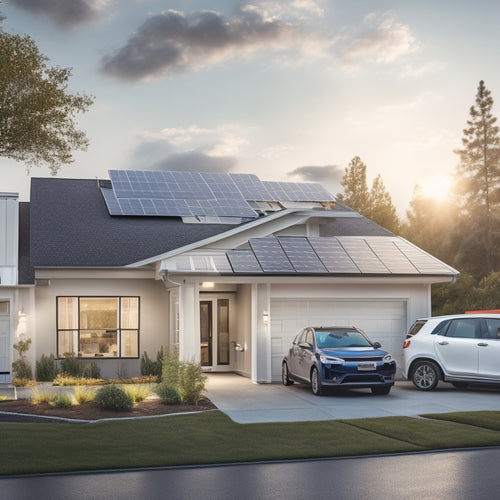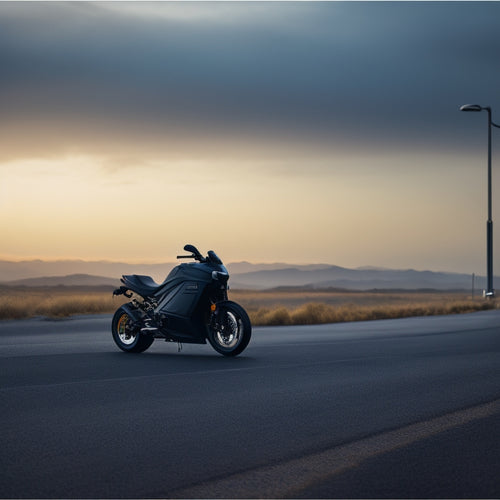
Solar Panel System Installation Checklist for Houses
Share
You're about to initiate a critical expedition - guaranteeing a seamless and efficient solar panel system installation on your house, which requires careful planning, attention to detail, and a thorough understanding of the entire process. Start by evaluating your home's suitability, selecting high-quality equipment, and preparing your roof for installation. Next, you'll need to choose the right mounting system, verify electrical connections are made safely and correctly, and conduct thorough inspections and performance tests. From there, you'll finalize documentation and reporting, but that's just the beginning of your expedition to utilizing renewable energy - and there's more to examine ahead.
Key Takeaways
- A thorough home suitability assessment is crucial to ensure the roof can support the solar panel system and optimize energy usage.
- High-quality solar panels with efficiency ratings above 20% and warranties of 25 years or more should be selected for optimal energy production.
- Roof preparation and inspection are essential to ensure the roof can support the additional weight of the panels and identify any structural issues.
- Electrical connections and wiring must be properly installed, verified, and tested to ensure safe and efficient energy transmission.
- A comprehensive final inspection and performance testing are necessary to ensure all components are functioning properly and safely before grid connection.
Assessing Your Home's Suitability
Before installing solar panels, assess your home's suitability by evaluating its solar potential. This involves analyzing your roof's size, orientation, and shading to determine how much energy your solar panel system can produce.
You'll want to contemplate the amount of direct sunlight your roof receives daily, considering any obstructions like trees or neighboring buildings.
Next, inspect your roof's condition to verify it can support the weight of the solar panels. You'll need to check for signs of wear, damage, or structural issues that may require repairs before installation.
Additionally, reflect on your energy usage and how it can be optimized for energy efficiency. This may involve making adjustments to your appliances, lighting, and insulation to maximize the benefits of your solar panel system.
As a homeowner, you may be eligible for incentives like tax credits or rebates, which can help offset the cost of installation.
Choosing the Right Equipment
You'll need to select high-quality solar panels that meet specific quality factors, including efficiency, durability, and warranty.
Additionally, make certain the panels are compatible with your system's inverters, mounting hardware, and other components.
Panel Quality Factors
During the solar panel installation process, selecting high-quality equipment is crucial to assure peak performance, reliability, and longevity. You need to take into account several factors to guarantee you get the right panels for your system.
| Panel Quality Factors | Description | Key Considerations |
|---|---|---|
| Efficiency Ratings | Measures how well panels convert sunlight into electricity | Look for high efficiency ratings (>20%) for maximum energy production |
| Warranty Considerations | Manufacturer's guarantee for panel performance and durability | Opt for panels with a 25-year warranty or more for long-term reliability |
| Durability and Build Quality | Ability of panels to withstand environmental stressors | Choose panels with durable materials and strong construction for withstanding harsh weather conditions |
| Certifications and Compliance | Adherence to industry standards and regulations | Verify panels meet local and international certifications, such as UL and IEC |
When evaluating panel quality, you should prioritize efficiency, warranty, and durability. By doing so, you'll be able to generate more power and enjoy a longer system lifespan.
System Compatibility Checks
When selecting solar panels, one crucial aspect to take into account is how they'll integrate with the rest of your system.
You want to guarantee that all the components work seamlessly together to maximize energy efficiency and optimize your investment.
To achieve this, you need to check the compatibility of your solar panels with other system components, such as inverters, mounting systems, and monitoring systems.
Here are some key factors to contemplate:
-
Inverter compatibility: Confirm the inverter is compatible with your solar panel's voltage and current output to optimize energy conversion.
-
Mounting system compatibility: Verify that the mounting system is designed for your roof type and can support the weight and size of your solar panels.
-
Monitoring system integration: Check if the monitoring system is compatible with your solar panel's communication protocol to guarantee accurate performance tracking.
-
Grid connection requirements: Ascertain your system meets the grid connection requirements of your utility company to qualify for financial incentives.
-
Compatibility with energy storage systems: If you plan to add energy storage, verify that your solar panels are compatible with the battery management system.
Roof Preparation and Inspection
Your roof serves as the foundation for your solar panel system, so it's essential to guarantee it's prepared for the installation. Before installing your solar panels, you'll need to inspect your roof to confirm it's structurally sound and suitable for the additional weight of the panels.
You'll need to take into account the type of roof you have, as different roof types require different preparation methods. For example, asphalt shingle roofs may require additional support, while metal roofs may need specialized mounting equipment.
You'll also need to evaluate the structural integrity of your roof, checking for signs of damage, rot, or sagging.
Additionally, you'll need to clear your roof of any debris, such as leaves or branches, and verify that all skylights, vents, and chimneys are securely sealed. This will prevent any damage to your roof or solar panels during installation.
Installation and Mounting Systems
You'll need to decide on a mounting system that suits your solar panel installation, and you have two primary options to evaluate.
For rooftop installations, you'll choose from various roof mounting options, such as rail-based, rail-less, or shared rail systems, each with their own set of advantages and disadvantages.
Alternatively, you may opt for a ground mounting system, which can be fixed-tilt, tracking, or seasonal adjustment systems, depending on your energy generation goals and available land.
Roof Mounting Options
Selecting the right roof mounting option is essential to guaranteeing a secure and efficient solar panel installation. You'll need to take into account factors such as aesthetic considerations, roof material, and structural integrity.
When choosing a roof mounting system, keep in mind the following options:
-
Rail-based systems: These are the most common type, using rails to secure the solar panels to the roof.
-
Rail-less systems: These systems use clamps to attach the panels directly to the roof, eliminating the need for rails.
-
Shared rail systems: These systems use a single rail to secure multiple panels, reducing material costs.
-
Standoff-based systems: These systems use standoffs to raise the panels above the roof, allowing for airflow and easy maintenance.
-
Integrated mounting systems: These systems are built into the solar panels themselves, eliminating the need for separate mounting hardware.
When evaluating these options, take into account factors such as durability, adjustability, and compatibility with your roof material.
Ground Mounting Systems
Most solar panel installations involve roof mounting, but ground mounting systems offer a viable alternative for properties with ample land or those with complex roof structures.
When considering a ground mounting system, you'll need to assess your ground site considerations, including the terrain, soil type, and available space. Make certain the area is clear of obstacles and vegetation, and that the ground can support the weight of the system.
You'll also need to obtain the necessary installation permits from your local authorities before commencing the project. This may involve submitting your system design and site plans for approval. Additionally, you'll need to comply with local building codes and regulations.
Ground mounting systems typically consist of a racking system, tracker, and foundation. The racking system secures the solar panels in place, while the tracker follows the sun's movement to optimize energy production.
The foundation provides a stable base for the system, which can be anchored to the ground using various methods, such as concrete footings or helical piers. Properly installing a ground mounting system requires careful planning and execution to ascertain a safe and efficient solar panel system.
Electrical Connections and Wiring
When it comes to utilizing the power of solar energy, electrical connections and wiring play a critical role in guaranteeing a safe and efficient system.
You want to make certain that your solar panel system is installed correctly to avoid any electrical hazards and optimize energy production.
-
Verify that all electrical connections are secure and meet local electrical codes and standards.
-
Confirm that wiring is sized correctly to handle the electrical load of your solar panel system.
-
Check that wiring is protected from environmental factors such as water, heat, and physical damage.
-
Confirm that all wiring is labeled and documented correctly for future maintenance and repair.
-
Ensure that wiring safety is maintained by following proper lockout/tagout procedures during maintenance and repair.
Final Inspection and Testing
You've completed the electrical connections and wiring, now it is crucial to perform a thorough final inspection and testing to confirm your solar panel system operates safely and efficiently. This step guarantees that your system meets the necessary safety protocols and is ready for grid connection.
During the final inspection, verify that:
| Component | Inspection Item | Status |
|---|---|---|
| Solar Panels | Cleanliness, damage, or misalignment | |
| Inverters | Proper installation, wiring, and configuration | |
| Mounting System | Secure fastening, corrosion, or signs of wear |
Conduct a series of tests to validate the system's performance, including:
- Insulation resistance testing
- Earth fault loop impedance testing
- Operational testing of the entire system
Once you've completed the final inspection and testing, prepare the final documentation, including:
- System commissioning report
- Test results and certifications
- Operation and maintenance manuals
Frequently Asked Questions
Can I Install Solar Panels Myself to Save Money?
You're considering a DIY installation to reap cost savings, but be aware that improper installation can void warranties, lead to safety hazards, and reduce system efficiency, potentially offsetting any upfront savings.
How Long Does a Typical Solar Panel System Last?
You can expect a typical solar panel system to last around 25-30 years, but with proper maintenance, you might squeeze out up to 40 years of efficient energy production, depending on the manufacturer's warranty and your maintenance requirements.
Are Solar Panels Compatible With All Roof Types?
You're probably wondering if solar panels will work on your roof, and the answer is a resounding yes! While not all roof materials are created equal, most can support solar panels, as long as you choose the right installation angles to maximize energy harvesting.
Do Solar Panels Increase My Home's Property Value?
You'll likely see an increase in your home's property value with solar panels, as they spark home buyer interest and potentially enhance resale value, although you'll want to evaluate property tax implications to maximize your investment's return.
Will Solar Panels Still Generate Power During a Blackout?
During a blackout, you won't generate power solely with solar panels, but you can invest in solar energy storage solutions, ensuring blackout preparedness and supplying electricity when you need it most, giving you control over your power.
Related Posts
-

What Electric Vehicle Owners Need for Home Energy
As an electric vehicle owner, you need to optimize your home energy system to guarantee efficient, sustainable, and c...
-

Why Electric Motorcycles Fail at Long-Distance Touring
You're likely familiar with the excitement of hitting the open road on an electric motorcycle, but you're also smart ...
-

Charging Station Incentives: Why So Many Are Free
You're likely to stumble upon free or low-cost charging stations due to a convergence of incentives. Government rebat...


